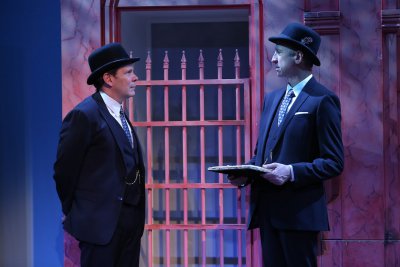Travels with My Aunt
Entertaining and witty stage adaptation of the Graham Greene novel using a challenging concept as four men play all 25 of the roles as well as alternating as the hero.

Daniel Jenkins, Jay Russell and Thomas Jay Ryan in a scene from “Travels with My Aunt” (Photo credit: Carol Rosegg)
[avatar user=”Victor Gluck” size=”96″ align=”left” ] Victor Gluck, Editor-in-Chief[/avatar] Aside from Graham Greene’s serious novels which made him a perennial candidate for the Nobel Prize, he wrote lighter books and thrillers he called “Entertainments.” One of the most popular of these was his 1969 picaresque novel, Travels with My Aunt, a sort of British Auntie Mame. Filmed in 1972 and dramatized for the stage by Scottish playwright Giles Havergal in 1989, its Off Broadway production in 1995 starred Jim Dale and Brian Murray. As part of its 2015-16 season, Keen Company has given this unusual play its first New York revival in 20 years in a production by artistic director Jonathan Silverstein.
Havergal’s adaptation is unusual in that it uses four male actors to play 25 roles including the central role of Aunt Augusta, with all the actors taking turns narrating the story. Dressed exactly alike in each act, Thomas Jay Ryan, Jay Russell, Daniel Jenkins and Rory Kulz switch identities, nationalities, age, and genders in a madcap adventure told with decided British understatement. This is challenging for the audience as well as the actors: since the performers do not change costumes, it is necessary to follow the plot closely to follow who is who, with the actors sometimes changing characters in the same scene. Steven C. Kemp’s minimal but clever unit set is not much help either as it remains basically the same in each act throughout all of the outrageous adventures that unlikely hero Henry Pulling is taken on by his aunt.
Two years into his retirement as a London bank manager, 55-year-old, dry, dusty Henry meets his septuagenarian Aunt Augusta for the first time in 50 years at his mother’s funeral. Aunt Augusta is not impressed that he is spending his retirement raising dahlias and carrying on a correspondence with an heiress whose hobby is tatting. She immediately drops the bombshell that though Henry was his father’s child, he was not his mother’s. She invites him to her home where he meets Wordsworth, her large African butler from Freetown, Sierra Leone. And so begins Henry’s travels with his aunt.
When Aunt Augusta suggests a little trip, Henry arranges for an outing to Brighton where a fortune teller tells him that he “will do a lot of traveling with a lady friend.” Immediately after, he finds himself in Paris boarding the Orient Express to Istanbul with his aunt to help save the love of her life, Mr. Visconti. He suspects that she is doing a bit of smuggling. The more we learn about Aunt Augusta, the more amoral and liberated she becomes, but unlike Henry she has lived while he has vegetated. When Henry returns to Southwood, his old life of raising dahlias no longer fulfills him. Eventually, the adventures take Henry to South America where he becomes involved with crime and politics and finds love. Henry’s old life is gone forever.
The four versatile actors are in tune with the low-key style of the play and with Silverstein’s direction. All of the actors play Henry at one time or another, but only Ryan plays Aunt Augusta. While Patrick Dennis’ Auntie Mame is always played as over-the-top, Ryan’s Aunt Augusta is always restrained and understated, stating her revelations in so matter-of-fact a way as to make them all the more outrageous. Russell is mainly seen as the retiring, prim and proper Henry and he is the epitome of these characteristics while demonstrating his versatility in other roles as well such as the CIA agent O’Toole and Frau General Schmidt. Alternating with Russell as Henry, Jenkins shows his expertise with accents and foreign mannerisms as the African Wordsworth, Turkish Colonel Hakim, the English Detective Sgt. Sparrow, the Italian Mr. Visconti, and a Spanish Gentleman. Playing everything from a Girl in Jodhpurs to an Irish wolfhound, Kulz is mainly underutilized in minor roles.
The production design is as subtle as the play and the staging. Jennifer Paar has the men in identical dark three-piece suits and bowler hats in Act I set in Europe and in white suits and straw hats suitable for the tropics in the second when Henry travels to Argentina and Paraguay. Kemp’s unit set (white for Act I, pink for Act II) has hidden objects which are revealed in the set, but basically the eye is left to fill in the details of their travels. The lighting changes by Josh Bradford are inconspicuous and unobtrusive.
Jonathan Silverstein’s revival of Travels with My Aunt is both challenging and understated so that its pleasures are low-key and refined. With Graham Greene’s witty, extravagant and fanciful plot and the creative acting of its four performers, Travels with My Aunt is an exquisite jewel that is not for everyone. However, the evening does have a good deal to teach us about living life to the fullest and not settling for easy compromises that we may come to regret.
Travels with My Aunt (through November 14, 2015)
The Clurman Theatre at Theatre Row, 410 W. 42nd Street, in Manhattan
For tickets, call 212-230-6200 or visit http://www.telecharge.com
For information, visit http://www.keencompany.org
Running time: two hours and ten minutes including one intermission







Leave a comment